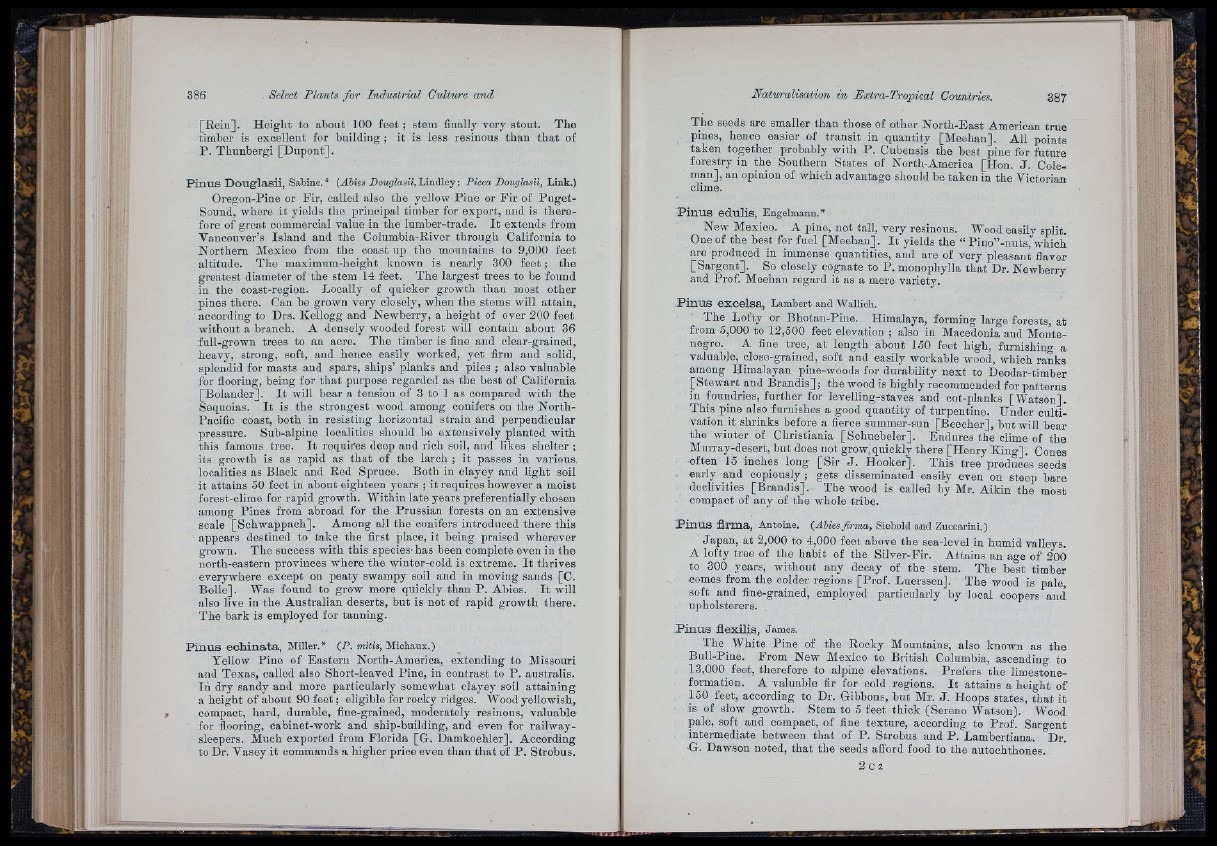
ì :L- !]
S. li
[Rein]. Height to about 100 feet ; stem finally very stout. The
timber is excellent for building ; it is less resinous than th a t of
P. Thunbergi [Dupont].
Pinus Douglasii, Sabine.* (Abies Douglasii, Lindley; Picea Douglasii, Link.)
Oregon-Pine or Fir, called also the yellow Pine or F ir of Puget-
Sound, where it yields the principal timber for export, and is therefore
of great commercial value iu the lumber-trade. I t extends from
Vancouver’s Island and the Columbia-River through California to
Northern Mexico from the coast up the mountains to 9,000 feet
altitude. The maximum-height known is nearly 300 f e e t; the
greatest diameter of the stem 14 feet. The largest trees to be found
in the coast-region. Locally of quicker growth than most other
pines tliere. Can be grown very closely, when the stems will attain,
according to Drs. Kellogg and Newberry, a height of over 200 feet
without a brancli. A densely wooded forest will contain about 36
full-grown trees to an acre. The timber is fine and clear-grained,
heavy, strong, soft, and hence easily worked, yet firm and solid,
splendid for masts and spars, ships’ planks and piles ; also valuable
for flooring, being for th a t purpose regarded as the best of California
[Bolander]. I t will bear a tension of 3 to 1 as compared with the
Sequoias. I t is the strongest wood among conifers on the North-
Pacific coast, both in resisting horizontal strain and perpendicular
pressure. Sub-alpine localities should be extensively planted with
this famous tree. I t requires deep and rich soil, and likes shelter ;
its growth is as rapid as th a t of the larch ; it passes in various,
localities as Black and Red Spruce. Both in clayey and light soil
it attains 50 feet in about eighteen years ; it requires however a moist
forest-clime for rapid growth. Within late years preferentially chosen
among Pines from abroad for the Prussian forests on an extensive
scale [Schwappach]. Among all the conifers introduced there this
appears destined to take the first place, it being praised wherever
grown. The success with this species' has been complete even in the
north-eastern provinces where the winter-cold is extreme. I t thrives
everywhere except on peaty swampy soil and in moving sands [C.
Bolle]. Was found to grow more quickly than P . Abies. I t will
also live in the Australian deserts, but is not of rapid growth there.
The bark is employed for tanning.
Pinus echinata, Miller.* (P. mitis, Michaux.)
Yellow Pine of Eastern North-Amerioa, extending to Missouri
and Texas, called also Short-leaved Pine, iu contrast to P . australis.
In dry sandy and more partioularly somewhat clayey soil attaining
a height of about 90 fe e t; eligible for rocky ridges. Wood yellowish,
compact, hard, durable, fine-grained, moderately resinous, valuable
for flooring, cabinet-work and ship-building, and even for railway-
sleepers. Much exported from Florida [G. Damkoehler]. According
to Dr. Vasey it commands a higher price even than th a t of P . Strobus.
Naturalisation in Extra-Tropical Countries. 387
The seeds are smaller than those of other North-East American true
pines, hence easier of transit in quantity [Meehan]. All points
taken together probably with P . Cubensis the best pine for future
forestry iu the Southern States of North-America [Hon. J . Coleman],
an opinion of which advantage should be taken iu the Victorian
clime.
Pinus edulis, Engelmann.*
New Mexico. A pine, not tall, very resinous. Wood easily split.
One of the best for fuel [Meehan]. I t yields the “ Pino” -nuts, which
are produced in immense quantities, and are of very pleasant flavor
[Sa rg en t]. So closely cognate to P . monophylla th a t Dr. Newberry
and Prof. Meehan regard it as a mere variety.
Pinus excelsa, Lambert and Wallich.
The Lofty or Bhotan-Pine. Himalaya, forming large forests, at
from 5,000 to 12,500 feet elevation ; also in Macedonia and Montenegro.
A fine tree, a t length about 150 feet high, furnishing a
valuable, close-grained, soft and easily workable wood, which ranks
among Himalayan pine-woods for durability next to Deodar-timber
[Stewa rt and Bran d is]; the wood is highly recommended for patterns
in foundries, further for levelling-staves and cot-plauks [Watson].
This pine also furnishes a good quantity of turpentine. Under cultivation
it shrinks before a fierce summer-sun [Beecher], but will bear
the winter of Christiania [Schuebeler]. Endures the clime of the
Murray-desert, but does not grow,quickly there [Henry Kin g ]. Cones
often 15 inches long [S ir J . Hooker]. This tree produces seeds
early and copiously ; gets disseminated easily even on steep bare
declivities [Brandis]. The wood is called by Mr. Aikiu the most
compact of any of the whole tribe.
P in u s flrma, Antoine. (Abies firma, Siebold and Zuccarini.)
Japan, at 2,000 to 4,000 feet above the sea-level in humid valleys.
A lofty tree of the habit of the Silver-Fir. Attains an age of 200
to 300 years, without any decay of the stem. The best timber
comes from the colder regions [Prof. Luerssen]. The wood is pale,
soft and fine-grained, employed particularly by local coopers and
upholsterers.
Pinus flexiRs, James.
The White Pine of the Rooky Mountains, also known as the
Bull-Pine. From New Mexico to British Columbia, ascending to
13,000 feet, therefore to alpine elevations. Prefers the limestone-
formation. A valnable fir for cold regions. I t attains a height of
]5 0 feet, according to Dr. Gibbons, but Mr. J . Hoops states, th a t it
is of slow growth. Stem to 5 feet thick (Sereno Watson). Wood
pale, soft and compact, of fine texture, according to Prof. Sargent
intermediate between th a t of P. Strobus and P. Lambertiana. Dr.
G. Dawson noted, th a t the seeds afford food to the autochthones.